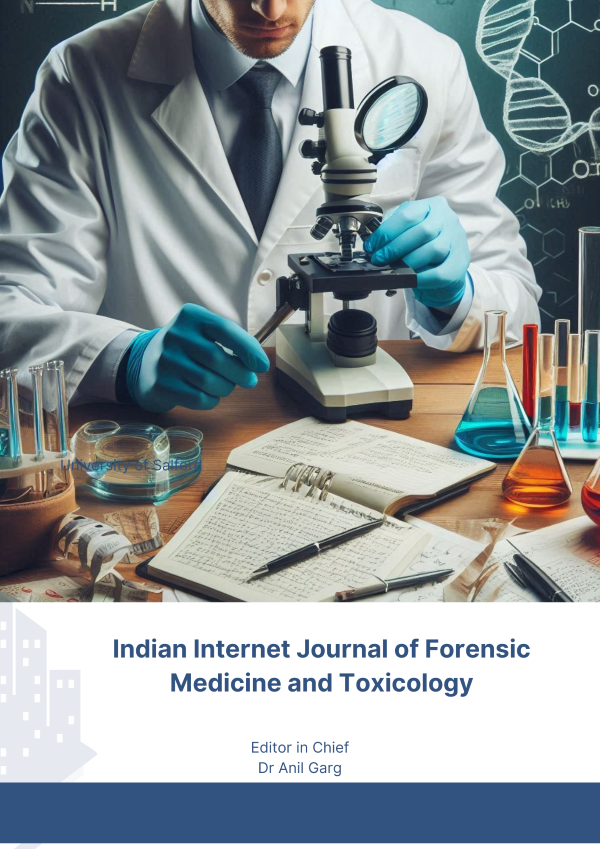Reconstruction of Stature by Percutaneous Measurement of Hand: An Anthropometric Study
DOI:
https://doi.org/10.48165/Keywords:
Dismembered remains, Hand, Multiplication factor, Regression equation, Stature, Tip of middle finger, WristAbstract
Stature is one of the important criteria for establishing identification of unknown person/dead body. Reconstruction of stature is a tedious job when dead bodies are mutilated, burnt or skeletonised. In this study, attempt is made to reconstruct stature by percutaneous measurement of hand as in cases of dismembered remains where most of other body parts are damaged. Stature is calculated from the length of hand which is the distance from the mid-point of styloid process of radius and ulna on the back of wrist to tip of middle finger. Standing height and length of hand are measured in 100 adult male and female students of 19–25 years of age and regression equation is derived by using formula. ݕ = ߨݕߜݔߜ̅.ݕ − (̅ݔ − ݔ) Here x stands for length of hand and y the standing height. Regression equations are derived separately for both the sexes which is 5.1x + 67.9 for male and 4.8x + 70.2 for female. The multiplication factor for hand is 8.5 & 8.7 for male and female, respectively. Stature calculated by regression equations is found close to the actual height (±3 cm) and by multiplication factors, it is more than ±5 cm in large number of the cases. This indicates regression equations are superior and more reliable than multiplication factors.
Downloads
References
[1] Kumar A, Srivastava AK, Verma AK. Estimation of stature by percutaneous measurements of distal half of upper limb (forearm & hand). Journal of Indian Academy of Forensic Medicine 2010;32(4):325–8.
[2] Kumar A, Srivastava AK, Rastogi AK. Estimation of stature by percutaneous measurements of leg (Knee to Heel). International Journal of Forensic Practice & Research 2011;1(2):83–7.
[3] Srivastava AK, Srivastava A, Kumar A, Kumar JVK. Reconstruction of stature by percutaneous measurement of foot: an anthropometric study. Indian Internet Journal of Forensic Medicine & Toxicology 2013;11(3):59–62.
[4] Jasuja OP. Estimation of stature from hand and phalange length. Journal of Indian Academy of Forensic Medicine 2004;26(3):100–6.
[5] Krishan K, Kanchan T, Kharoshah M. Estimation of stature from hand print dimensions – Positional variations in real crime situations. Egyptian Journal of Forensic Sciences 2015;5:129–31.
[6] Krishan K, Sharma A. Estimation of stature from dimensions of hands and feet in a North Indian population. Journal of Forensic and Legal Medicine 2007;14:327–32.
[7] Kumar S, Dikshit PC, Aggarwal A, Rani M. Estimation of stature from hand length. Journal of Indian Academy of Forensic Medicine 2005;27(4):219–21.
[8] Patel J, Patel B, Shah R, Bhojak N, Desai J. Estimation of stature from hand length in Gujarat region. NHL Journal of Medical Sciences 2014;3(1):41–4.
[9] Rastogi P, Yoganarasimha K. Stature estimation using palm length in Indian population. International Journal of Medical Toxicology & Legal Medicine 2008;11:37– 41.

